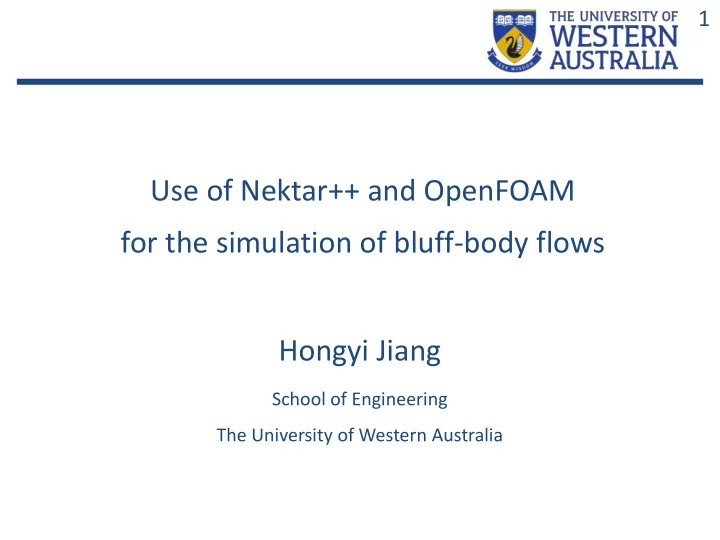

1 Use of Nektar++ and OpenFOAM for the simulation of bluff-body flows Hongyi Jiang School of Engineering The University of Western Australia
2 Introduction y (transverse) U D UD Reynolds number Re / u u u u u u y y Vorticity z x z x u , , y z z x x y (a measure of the rotation of the velocity field)
3 Introduction A nominally 2D cylinder → A 3D flow Re = 220, Mode A (3D) Re = 100, 2D
4 Introduction Re = 100, 2D Re = 220, Mode A
5 Introduction (a) Re = 45 (2D steady) (b) Re = 185 (2D unsteady) (c) Re = 194 (Mode A*) (d) Re = 270 (Mode B) (e) Re = 400 (Mode B) (f) Re = 1000 (Mode B)
6 Advantage 1 A weak but persistent Mode A flow (OpenFOAM)
7 Advantage 1 Experimental evidence: (Williamson, 1996. Three-dimensional wake transition. J. Fluid Mech. 328, 345 – 407.) End of story?
8 Advantage 1 (a) Re = 100, u z = ±2×10 -5 (b) Re = 100, u z = ±2×10 -6 Mesh skewness → Three dimensionality ( → Stable mode A)
9 Advantage 1 0 10 Beyond Re cr -2 10 Standard 3D mesh -4 10 Modified 3D mesh E z -6 10 -8 10 -10 10 100 125 150 175 200 Re Mesh skewness ↓ → Three dimensionality ↓
10 Advantage 1 Nektar++ results: Transient growth and then decay to 2D. Nektar++ (Fourier) Transient initial disturbance OpenFOAM (Replication) Persistent disturbance (uncontrolled) Experiment Real-life flow with ambient disturbance (Jiang et al ., 2016. Phys. Fluids 28, 104103.)
11 Advantage 2 Primary Two-layered Secondary Vorticity field at Re = 300 calculated with 2D DNS. Location for the onset of the secondary vortex street ( Re = 200): Vorobieff et al. (2002) x / D = 60 Kumar and Mittal (2012) x / D = 100 Thompson et al. (2014) Not within x / D = 280 But there has been no mesh independence check on the far-wake mesh.
12 Advantage 2 240 OpenFOAM 1 ~ 2000 elements Nektar N p =2 OpenFOAM 2 200 for x / D < 2 and Nektar N p =5 44,000 elements 160 for x / D = 2 – 400 40 120 x/D 39 Nektar N p =3 The second 80 38 transition 400 Nektar N p =6 40 The first transition 0 0 200 400 600 800 1000 Re For extremely mesh-sensitive cases, Nektar++ shows better convergence. (Jiang et al ., 2019. J. Fluid Mech. 867, 691 – 722.)
Recommend
More recommend